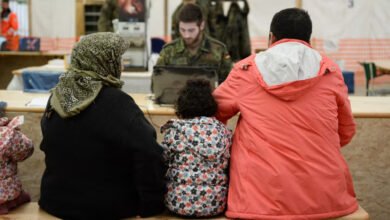It only takes a one-hour drive from Damascus past a majestic mountain range to reach Ma’loula, one of the best locations to spend Easter Sunday.
Ma’loula is located 56km northeast of the Syrian capital at an altitude of 1500 meters. It’s a beautifully small and simple village built into the rugged mountainside. Its rich history is immediately palpable to visitors upon arrival.
Ma’loula is one of two remaining villages in Syria where Aramaic (the language of Jesus Christ) is still spoken. It is likely that seclusion within the mountains has enabled these villages to become havens for linguistic preservation.
We arrive to attend prayers at the Convent of Saints Sergius and Bacchus–named in honor of two Syrian soldiers–which houses a church, parts of which are said to be the only remnants of one of the world’s oldest churches. Though catering mostly to tourists, it remains one of the oldest active churches in the world.
Our 30-minute walk to the church begins at the Mar Taqla monastery, which holds the remains of Saint Taqla, a pupil of Saint Paul. According to legend, Taqla reached the mountains near Ma’loula while escaping death at the hands of her father after converting to Christianity. Unable to cross, God opened a passageway leading her to Ma’loula, where she stayed until her death.
While approaching the monastery, loudspeakers project Christian hymns. A sense of reverence engulfs visitors as they walk around in complete silence. First we enter a small church and climb a staircase leading to the burial place of Saint Taqla, tucked away in the mountainside overlooking Ma’loula. There we pay our respects and drink water that is said to be blessed and sourced from a well that has not run dry since the arrival of Saint Taqla.
To reach the church in the Convent of Saints Sergius and Bacchus we walk through a passage way winding through the mountains, which is said to be the same path Saint Taqla took to Ma’loula. The heat is intense due to the dry terrain, but walking through the shady mountains is solemn and enjoyable.
Upon reaching the church in the Convent we are greeted by a church member who offers to narrate the building’s history. She points to the architecture, highlighting the Byzantine influences. The back wall and entrance are the only remnants of the original church.
A prayer service is then held in Aramaic, followed by visitors lighting two candles–one for life and one for death–as they exit the church.
A few nearby restaurants overlooking the village host tourists for lunch before they drive back to Damascus at sunset.




